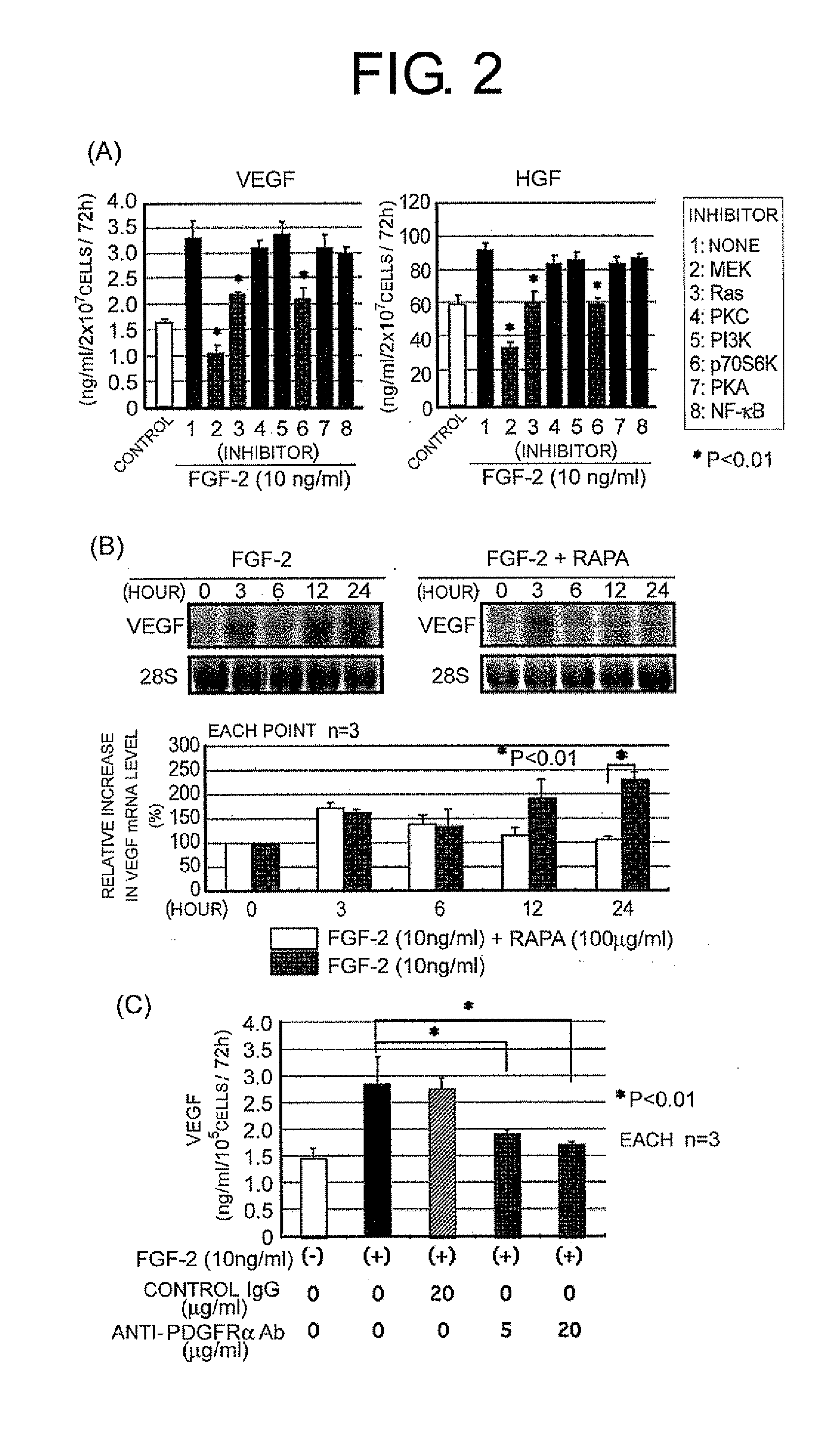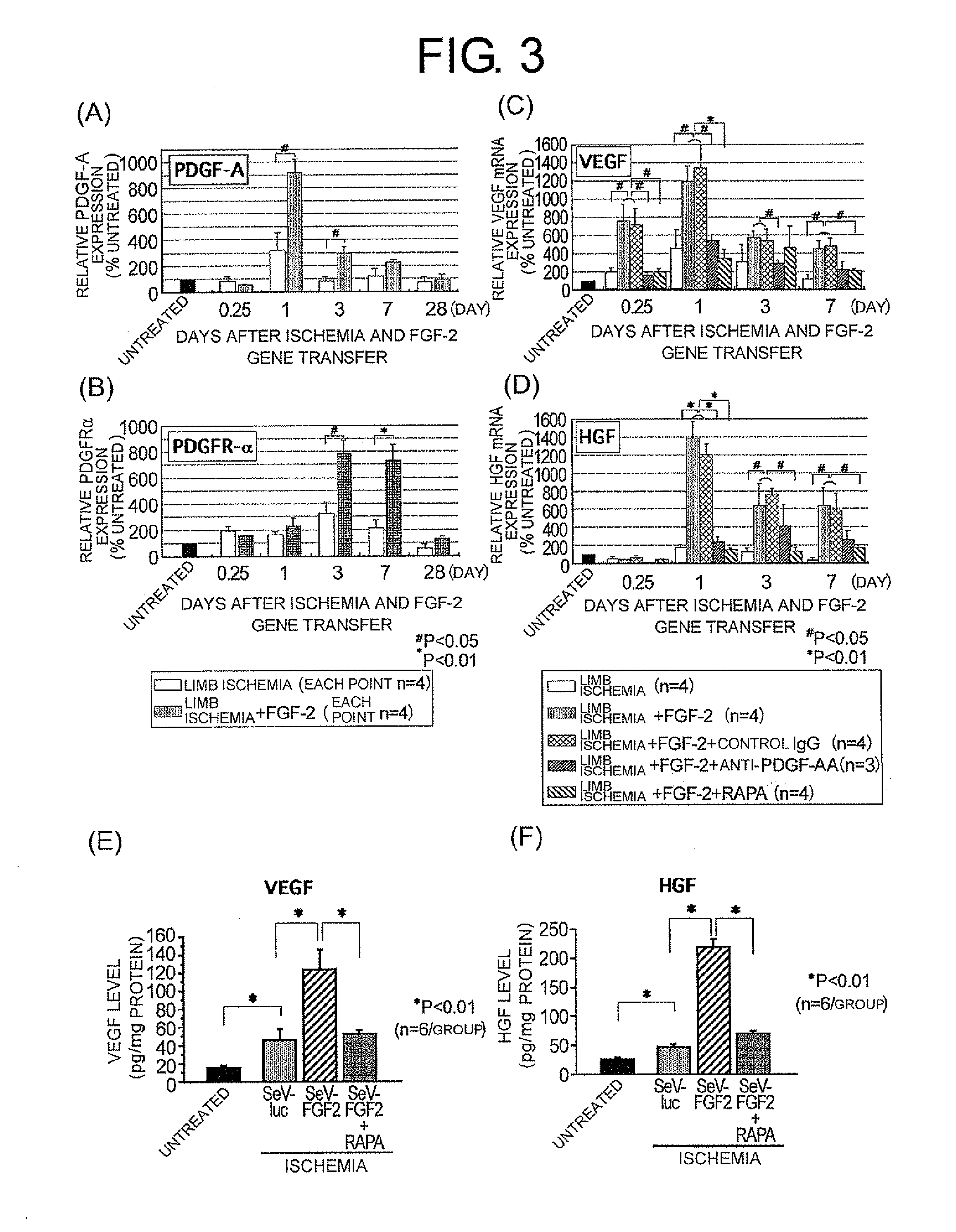Methods For Suppressing Tumor Proliferation
- Summary
- Abstract
- Description
- Claims
- Application Information
AI Technical Summary
Benefits of technology
Problems solved by technology
Method used
Image
Examples
example 1
[0124]This Example shows that FGF-2 and PDGF-AA cooperatively enhance the expression of VEGF and HGF / SF via FGF-2-mediated upregulation of PDGFRα.
[0125]To assess the role of the PDGF-AA signal in the angiogenic response of host vasculature, the FGF-2-mediated induction of VEGF and HGF in human mesenchymal cells (MRC5 and HSMC) cultured under serum-free conditions was investigated. As shown in FIG. 1A, while FGF-2 stimulated release of VEGF into the culture medium of MRC5 cells, PDGF-AA did not (FIG. 1A, left). Conversely it was found that while PDGF-AA upregulated the level of VEGF in the culture medium of HSMC, FGF-2 did not (FIG. 1A, right). On the other hand, co-stimulation using FGF-2 and PDGF-AA was found to cooperatively enhance the expression of VEGF (FIG. 1A) and HGF / SF (data not shown) in both MRC5 and HSMC cell types. Since FGF-2 and PDGF-AA were also seen to have a cooperative effect on the expression of VEGF and HGF in mouse fibroblast cell line NIH3T3 (data not shown), ...
example 2
[0126]This Example shows that in mesenchymal cells FGF-2 dependent expression of VEGF and HGF / SF is mediated by PDGFRα, and shut down by inhibition of the PDGFRα-p70S6K signal transduction pathway.
[0127]In addition to the cooperative effect of FGF-2 and PDGF-AA on the expression of VEGF and HGF / SF in MCs, the present inventors had previously discovered that FGF-2 enhances endogenous expression of PDGF-AA via Ras and p70S6K signal transductions, which contribute to the sustained expression of HGF / SF in HSMC (Onimaru M et al., Circ Res. 91: 723-730 (2002)). The present inventors hypothesized that an analogous system involving VEGF and MGF / SF expression also exists in fibroblasts (MRC5 cells). As seen in previous studies, FGF-2 typically upregulated the VEGF and HGF / SF proteins; and a MEK inhibitor, Ras-inhibitory peptide, and p70S6K inhibitor (RAPA) removed these effects (FIG. 2A). The repeated Northern blot analysis of time courses of FGF-2-mediated VEGF expression in MRC5 cells show...
example 3
[0128]This Example shows that PDGFRα plays a critical role in the therapeutic effect of FGF-2 on mouse severe limb ischemia.
[0129]In order to investigate the predictable cascade-like relationship of FGF-2, PDGFRα and VEGF / HGF in vivo, two separate mouse limb ischemia models, namely, C57BL / 6 mouse limb salvage model and balb / c nu / nu mouse limb autoamptation model (Masaki I et al., Circ Res. 90: 966-973 (2002)) were assessed in vivo using a recombinant Sendai virus (SeV-FGF2) that expresses FGF-2 (Masaki I et al., Circ Res. 90: 966-973 (2002); Onimaru M et al., Circ Res. 91: 723-730 (2002); Compagni A et al., Cancer Res. 60: 7163-7169 (2000); Yonemitsu Y et al., Nat. Biotechnol. 18: 970-973 (2000); Masaki I et al., FASEB J. 15: 1294-1296 (2001); Yamashita A et al., J. Immunol. 168: 450-457 (2002); Shoji F et al., Gene Ther. 10: 213-218 (2003)). FGF-2 overexpression was confirmed in the limb salvage model using ELISA assays (data not shown); however, upregulation of both PDGF-A and PDG...
PUM
| Property | Measurement | Unit |
|---|---|---|
| Solubility (mass) | aaaaa | aaaaa |
Abstract
Description
Claims
Application Information
 Login to View More
Login to View More - R&D
- Intellectual Property
- Life Sciences
- Materials
- Tech Scout
- Unparalleled Data Quality
- Higher Quality Content
- 60% Fewer Hallucinations
Browse by: Latest US Patents, China's latest patents, Technical Efficacy Thesaurus, Application Domain, Technology Topic, Popular Technical Reports.
© 2025 PatSnap. All rights reserved.Legal|Privacy policy|Modern Slavery Act Transparency Statement|Sitemap|About US| Contact US: help@patsnap.com



